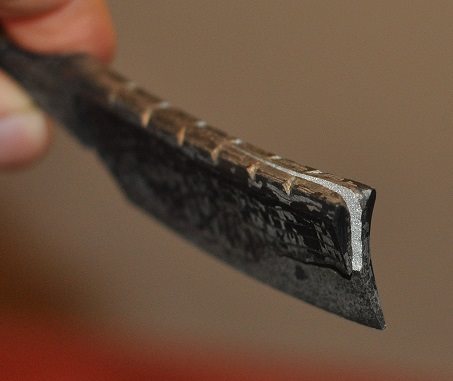Results 1 to 10 of 36
-
11-21-2015, 09:11 PM #1
 The best heat treatment for Suminagashi Steel
The best heat treatment for Suminagashi Steel
I got a peace of Suminagashi steel form here.
The description seems to me be heat treated in the same way as the O1. Is it right, or what else should be paying attention?gregg
-
11-21-2015, 09:40 PM #2

I have a Brian Brown (http://straightrazorpalace.com/membe...emarker60.html) - Badger & Blade LE from this material and I believe that Bruno (http://straightrazorpalace.com/members/bruno.html) has also.
Hopefully one of them will chime in...Support Movember!
Movember https://mobro.co/markcastellana?mc=1
SRP Team USA https://moteam.co/srp-usa?mc=1
-
The Following User Says Thank You to MJC For This Useful Post:
gregg71 (11-21-2015)
-
11-21-2015, 09:47 PM #3

I hope so.
 Thanks!
gregg
Thanks!
gregg
-
11-21-2015, 10:06 PM #4

It is indeed pretty much like O1. However, there are a few details you may want to mind. Firstly, you want to preheat the oil. Secondly, you will want no sharp indentations where the thermal shock could rip the sides apart. Otherwise one of the sides might peel away like a banana peel. Third you will want to do the tempering before you do anything else. Or the razor might still rip lengthwise.
Grinding it post HT can be a bit challenging because the hard edge material will behave very differently to the soft sides material.
You need to protect the edge while etching the material. Best etched with Ferric Chloride.
And if you are in the process of etching, and you notice that there are blotchy areas that won't etch black, it means that the HT has failed and those areas are not fully hardened.
Personally I don't like working it because the sides stay soft and you always need to hone with tape. And there is always the chance of small lengthwise cracks here or there.Til shade is gone, til water is gone, Into the shadow with teeth bared, screaming defiance with the last breath.
To spit in Sightblinder’s eye on the Last Day
-
The Following 3 Users Say Thank You to Bruno For This Useful Post:
gregg71 (11-21-2015), MJC (11-21-2015), ScottGoodman (11-22-2015)
-
11-22-2015, 12:09 AM #5
-
11-22-2015, 11:22 AM #6

I take a big chunk of mild steel, bring it to red heat, dunk it in the oil and stir it around. I think it is about 50 degrees celcius.
With ripping apart, I mean that the mild steel sides will contract very different from the steel core. If there are notches or ridges somewhere, that could be enough stress to rip a side from the steel. I have had this 2 or 3 times.
In this pic you can see that I had file a notch in the front side of the point. that was enough stress for the mechanical shock to just peel away one side. The data sheet also says you can do either water quench or oil quench. I suggest not doing water quench on a razor. Because the sides will still be very thick, and the contractions in the water quench are so strong that it can rip apart your razor even if you have no notches or ridges.
 Til shade is gone, til water is gone, Into the shadow with teeth bared, screaming defiance with the last breath.
Til shade is gone, til water is gone, Into the shadow with teeth bared, screaming defiance with the last breath.
To spit in Sightblinder’s eye on the Last Day
-
-
11-22-2015, 11:49 AM #7

I see. Thank you, Bruno!
gregg
-
11-22-2015, 10:19 PM #8

And this my friends is why custom Razor with exotic materials are expensive as the Smith has to make up for potentially losses of time & materials from failures just like these
Bruno, just a side question,
with simple carbon steels 1075 to 1095 steel I preheat my quenching oil (Canola) to 70°C as this is recommended for them & works for me with out trouble,
I would have thought the Suminagashi would have needed to have a warmer quench oil than 50° also to help avoid the potential losses like in your photo,
I know minor temperature changes can make a big difference when heat treating even a 50°C (6% of 800°) difference in the steel temp can effect it greatly?
as well as using a dunking v's swirling the blade motion in the oil during the initial quench movements,
this is only my thoughts as I have not used any San Mai or similar welded steels.
could this preheat temp difference also be due to the medium of Maize v's Canola oil?
sorry if this is rambling, I'm just thinking out loud with curiositySaved,
to shave another day.
-
11-23-2015, 12:24 AM #9

After reading about martempering, it seems that the speed from 220 C down to 100 C is where you want to slow things down to reduce stress. The temp of the oil would have a huge effect on the rate of cooling at these steel temps.
-
11-23-2015, 02:33 PM #10

That could very well be. In that case you could use a deep fryer to preheat the oil and quench in that.
In any case, no matter how you quench, the difference between the mild steel sides and the 1.3% carbon steel core means that there is always going to be the risk of a violent split.Til shade is gone, til water is gone, Into the shadow with teeth bared, screaming defiance with the last breath.
To spit in Sightblinder’s eye on the Last Day


 42Likes
42Likes LinkBack URL
LinkBack URL About LinkBacks
About LinkBacks






 Reply With Quote
Reply With Quote






